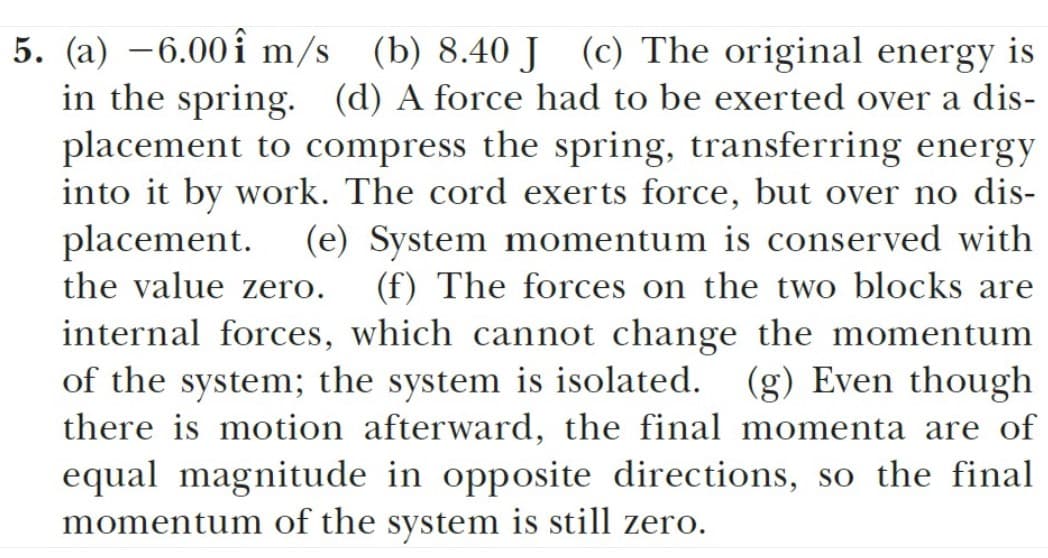m = 0.350 kg. (c) Is the original energy in the spring or in the cord? (d) Explain your answer to part (c). (e) Is the momentum of the system conserved in the bursting-apart process? Explain how that is possible considering (f) there are large forces acting and (g) there is no motion before- hand and plenty of motion afterward? Two blocks of masses m anu . are placed on a frictionless, hor- izontal surface. A light spring is attached to the more mas- 3m m sive block, and the blocks are Before pushed together with the spring between them (Fig. P9.5). 2.00 m/s A cord initially holding the blocks together is burned; after that happens, the block of mass 3m moves to the right with a speed of 2.00 m/s. (a) What is the velocity of the block of mass m? (b) Find the system's original elastic potential energy, taking 3m m After Figure P9.5
m = 0.350 kg. (c) Is the original energy in the spring or in the cord? (d) Explain your answer to part (c). (e) Is the momentum of the system conserved in the bursting-apart process? Explain how that is possible considering (f) there are large forces acting and (g) there is no motion before- hand and plenty of motion afterward? Two blocks of masses m anu . are placed on a frictionless, hor- izontal surface. A light spring is attached to the more mas- 3m m sive block, and the blocks are Before pushed together with the spring between them (Fig. P9.5). 2.00 m/s A cord initially holding the blocks together is burned; after that happens, the block of mass 3m moves to the right with a speed of 2.00 m/s. (a) What is the velocity of the block of mass m? (b) Find the system's original elastic potential energy, taking 3m m After Figure P9.5
Elements Of Electromagnetics
7th Edition
ISBN:9780190698614
Author:Sadiku, Matthew N. O.
Publisher:Sadiku, Matthew N. O.
ChapterMA: Math Assessment
Section: Chapter Questions
Problem 1.1MA
Related questions
Question
Solve f and g please

Transcribed Image Text:m = 0.350 kg. (c) Is the original energy in the spring or
in the cord? (d) Explain your answer to part (c). (e) Is the
momentum of the system conserved in the bursting-apart
process? Explain how that is possible considering (f) there
are large forces acting and (g) there is no motion before-
hand and plenty of motion afterward?
5. Two blocks of masses m allu e
QIC are placed on a frictionless, hor-
V izontal surface. A light spring
is attached to the more mas-
sive block, and the blocks are
3m
m
Before
pushed together with the spring
between them (Fig. P9.5).
A cord initially holding the
blocks together is burned; after
that happens, the block of mass
3m moves to the right with a
2.00 m/s
3m
m
speed of 2.00 m/s. (a) What is
the velocity of the block of mass
m? (b) Find the system's original
elastic potential energy, taking
After
b
Figure P9.5

Transcribed Image Text:5. (a) -6.00î m/s (b) 8.40J (c) The original energy is
in the spring. (d) A force had to be exerted over a dis-
placement to compress the spring, transferring energy
into it by work. The cord exerts force, but over no dis-
placement.
the value zero.
(e) System momentum is conserved with
(f) The forces on the two blocks are
internal forces, which cannot change the momentum
of the system; the system is isolated. (g) Even though
there is motion afterward, the final momenta are of
equal magnitude in opposite directions, so the final
momentum of the system is still zero.
Expert Solution
This question has been solved!
Explore an expertly crafted, step-by-step solution for a thorough understanding of key concepts.
Step by step
Solved in 2 steps with 1 images

Knowledge Booster
Learn more about
Need a deep-dive on the concept behind this application? Look no further. Learn more about this topic, mechanical-engineering and related others by exploring similar questions and additional content below.Recommended textbooks for you

Elements Of Electromagnetics
Mechanical Engineering
ISBN:
9780190698614
Author:
Sadiku, Matthew N. O.
Publisher:
Oxford University Press

Mechanics of Materials (10th Edition)
Mechanical Engineering
ISBN:
9780134319650
Author:
Russell C. Hibbeler
Publisher:
PEARSON

Thermodynamics: An Engineering Approach
Mechanical Engineering
ISBN:
9781259822674
Author:
Yunus A. Cengel Dr., Michael A. Boles
Publisher:
McGraw-Hill Education

Elements Of Electromagnetics
Mechanical Engineering
ISBN:
9780190698614
Author:
Sadiku, Matthew N. O.
Publisher:
Oxford University Press

Mechanics of Materials (10th Edition)
Mechanical Engineering
ISBN:
9780134319650
Author:
Russell C. Hibbeler
Publisher:
PEARSON

Thermodynamics: An Engineering Approach
Mechanical Engineering
ISBN:
9781259822674
Author:
Yunus A. Cengel Dr., Michael A. Boles
Publisher:
McGraw-Hill Education

Control Systems Engineering
Mechanical Engineering
ISBN:
9781118170519
Author:
Norman S. Nise
Publisher:
WILEY

Mechanics of Materials (MindTap Course List)
Mechanical Engineering
ISBN:
9781337093347
Author:
Barry J. Goodno, James M. Gere
Publisher:
Cengage Learning

Engineering Mechanics: Statics
Mechanical Engineering
ISBN:
9781118807330
Author:
James L. Meriam, L. G. Kraige, J. N. Bolton
Publisher:
WILEY